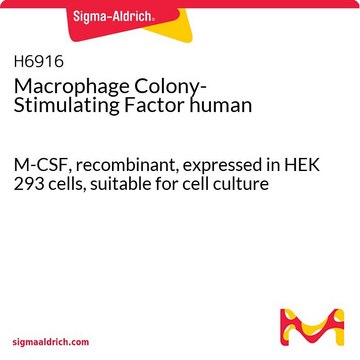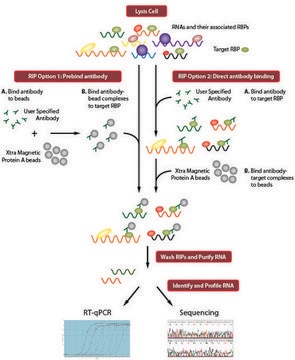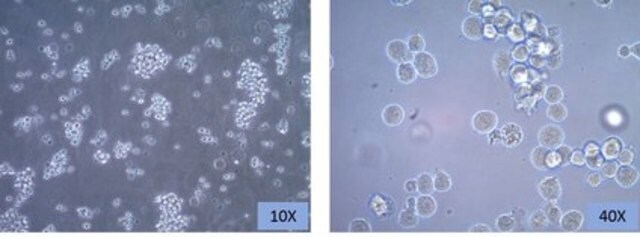SCC165
BLaER1 Human B-cell Precursor Leukemia Cell Line
Human
Synonyme(s) :
B cell Leukemia C/EBPalphaER clone 1
About This Item
Produits recommandés
Nom du produit
BLaER1 Human B-cell Precursor Leukemia Cell Line, BLaER1 human B-cell precursor leukemia cell line may be transdifferentiated and used to model human monocytes.
Source biologique
human
Technique(s)
cell culture | mammalian: suitable
Conditions d'expédition
ambient
Description générale
The BLaER1 cell line is a tamoxifen-inducible derivative of the RCH-ACV B-cell leukemia cell line genetically modified using a retrovirus vector to express C/EBPa fused with the estrogen receptor hormone binding domain (ER) and GFP . A study demonstrated that BLaER1 cells could efficiently convert into cells exhibiting increased adherent, phagocytic and quiescent properties with a transcriptome resembling normal macrophages . Cells retained their phenotype even when C/EBPa was inactivated, a characteristic of genuine cell reprogramming. C/EBPa induction also impaired cell tumorigenicity after transplantation into immunodeficient mice. BLaER1 is thus a model for highly efficient transdifferentiation of B-cell-derived human cancer cells.
Source:
BLaER1 cells are a single subclone isolated from C/EBPaER-GFP-transfected RCH-ACV acute lymphoblastic leukemia (ALL) cells sorted for GFP expression. The parental cell line was obtained from the bone marrow of a female with chromosome translocation 1;19 and trisomy 8 .
Biosafety Level 2:
BLaER1 cells contain squirrel monkey retrovirus (SMRV) and should be handled under biosafety level 2.
Description de la lignée cellulaire
Application
Qualité
- Each vial contains ≥1×10 viable cells.
- Cells are tested negative for infectious diseases by a Human Essential CLEAR panel by Charles River Animal Diagnostic Services.
- Cells are verified to be of human origin and negative for inter-species contamination from mouse, rat, chinese hamster, Golden Syrian hamster, and non-human primate (NHP) as assessed by a Contamination Clear panel by Charles River Animal Diagnostic Services
- Cells are negative for mycoplasma contamination.
- Cells tested positive for squirrel monkey retrovirus (SMRV).
Stockage et stabilité
Mention d'avertissement
Warning
Mentions de danger
Conseils de prudence
Classification des risques
Skin Sens. 1
Code de la classe de stockage
12 - Non Combustible Liquids
Classe de danger pour l'eau (WGK)
WGK 1
Point d'éclair (°F)
Not applicable
Point d'éclair (°C)
Not applicable
Certificats d'analyse (COA)
Recherchez un Certificats d'analyse (COA) en saisissant le numéro de lot du produit. Les numéros de lot figurent sur l'étiquette du produit après les mots "Lot" ou "Batch".
Déjà en possession de ce produit ?
Retrouvez la documentation relative aux produits que vous avez récemment achetés dans la Bibliothèque de documents.
Notre équipe de scientifiques dispose d'une expérience dans tous les secteurs de la recherche, notamment en sciences de la vie, science des matériaux, synthèse chimique, chromatographie, analyse et dans de nombreux autres domaines..
Contacter notre Service technique









